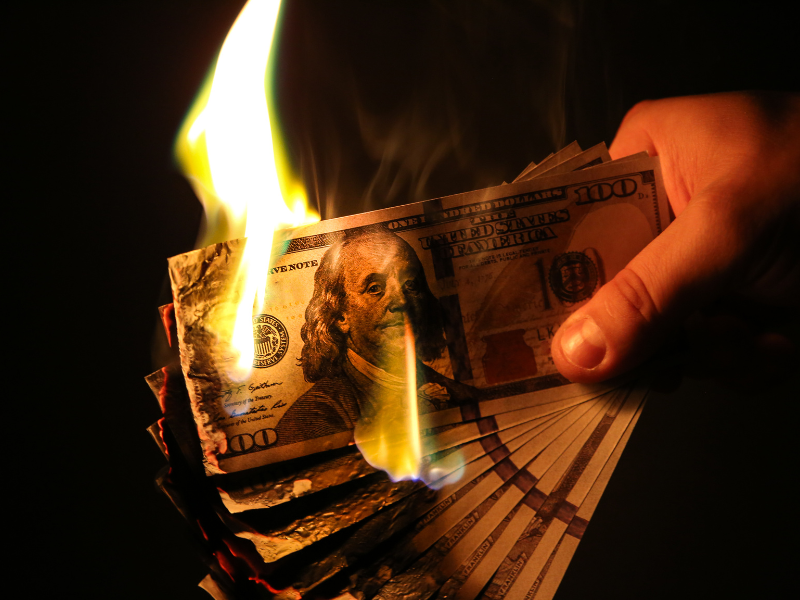For startups, cash flow isn’t just about keeping the lights on—it’s about ensuring long-term survival. Your burn rate and runway determine how much time you have before you need more funding or must reach profitability. Miscalculating either can leave you scrambling for capital when you least expect it.
Understanding what cash burn rate is, how to calculate it, and how to extend your startup runway is essential for making strategic financial decisions. Whether you’re preparing for a funding round, optimizing spending, or planning for sustainable growth, this guide will walk you through everything you need to know.
What Is Cash Burn Rate?
Simply put, cash burn rate is the amount of money your startup spends each month. It’s a key metric for understanding how quickly you’re using up available capital.
Cash Burn Rate Definition
Your monthly cash burn rate is the difference between your cash balance at the beginning and end of a given month. It measures how fast you’re spending money, factoring in operational expenses, payroll, rent, and other business costs.
If your expenses exceed your revenue, your burn rate tells you how long you can sustain operations before requiring additional funding.
How to Calculate Your Burn Rate
To get a clear picture of your cash burn, follow these calculations:
1. Gross Burn Rate
Gross burn rate represents your total operating expenses before considering revenue.
Formula: Gross Burn Rate = Total Monthly Operating Expenses
Example: If your startup spends $100,000 per month on salaries, rent, and other costs, your gross burn rate is $100,000 per month.
2. Net Burn Rate
Net burn rate factors in revenue and tells you how much cash you are actually losing per month.
Formula: Net Burn Rate = Total Monthly Operating Expenses − Monthly Revenue
Example If your expenses total $100,000 per month, but you generate $40,000 in revenue, your net burn rate is:
100,000 − 40,000 = 60,000
This means you are burning $60,000 per month.
How to Calculate Your Startup Runway
Your startup runway tells you how many months you have before you run out of money.
Formula: Runway = Total Cash on Hand / Net Burn Rate
Example: If your company has $300,000 in the bank and your net burn rate is $60,000 per month, your runway is:
300,000 / 60,000 = 5 months
This means your startup has 5 months of runway before you need more funding or must become cash-flow positive.
Let’s connect to explore how Ravix’s strategic financial planning can extend your startup’s runway.
How to Extend Your Startup Runway
Running out of cash is one of the top reasons startups fail. If your burn rate is high and your runway is shrinking, here are some strategies to help extend your financial lifeline.
1. Optimize Expenses Without Cutting Growth
Not all cost-cutting measures are equal. Review your expenses and identify non-essential costs while ensuring you maintain key investments in product development, sales, and marketing.
- Cancel unused software subscriptions and renegotiate vendor contracts.
- Reallocate marketing spend to channels with the highest ROI.
- Optimize workforce costs by leveraging fractional CFO and HR services.
2. Improve Cash Flow Efficiency
Delaying outflows and accelerating inflows can help extend your runway:
- Negotiate better payment terms with vendors to delay cash outflows.
- Shorten your accounts receivable cycle by offering early payment incentives.
- Consider alternative financing options like revenue-based funding.
3. Secure Additional Funding Early
If you anticipate needing venture capital or bridge financing, start the process well before you hit a financial crunch. Investors look at burn rate and runway closely, so a strong financial plan will improve your chances of securing funding.
- Plan your next fundraising round based on your runway needs.
- Leverage financial forecasting tools to present strong data to investors.
4. Increase Revenue Streams
Bringing in more revenue is the most effective way to extend your runway. Consider:
- Launching new product features that drive immediate sales.
- Exploring partnerships that generate recurring revenue.
- Monetizing existing assets such as proprietary data, licenses, or intellectual property.
Do You Have Enough Runway?
The right amount of runway depends on your growth stage, upcoming milestones, and funding strategy. Here’s a general guideline:
- Pre-Seed & Seed Stage: Aim for 12–18 months of runway.
- Series A & B Startups: Ideally 18–24 months to hit key milestones.
- Growth-Stage Companies: Aiming for 24+ months provides stability for scaling.
If your runway is short compared to industry norms, consider reducing burn, securing funding, or increasing revenue before you hit a crisis.
Final Thoughts: Burn Rate and Runway Are Startup Lifelines
Understanding cash burn rate and startup runway is critical to making informed financial decisions. Monitoring these metrics helps ensure your business stays financially healthy, whether you’re bootstrapping, raising venture capital, or preparing for profitability.
If your burn rate seems too high or your runway is too short, take action now. Optimizing expenses, improving cash flow, and securing funding early can help extend your startup’s survival and success.
Need help managing your startup’s burn rate and runway? Scheduled a call with Ravix. Our fractional CFO services can help you optimize spending, forecast runway, and make data-driven decisions to keep your business on track.

